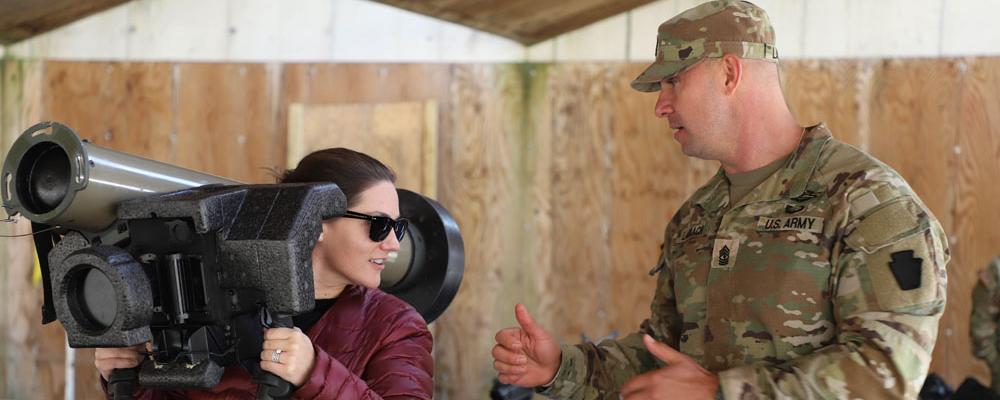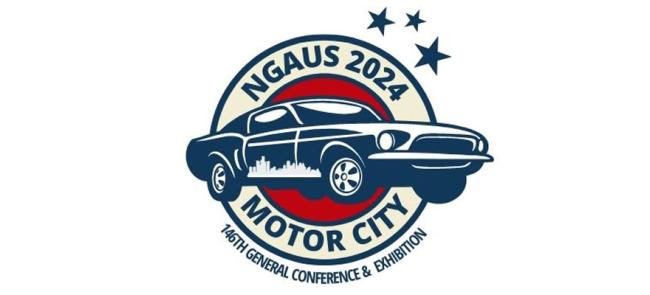
A Day in the Life
Hannah Frey has never served in the military; nevertheless, she has contributed to the nation’s defense and security.
Frey is director of operations for Accolade Technologies in Annapolis Junction, Maryland, which employs eight National Guardsmen and Reservists. Part of her job is to help the company’s part-time service members balance their civilian and military jobs.
After attending the Maryland National Guard’s Boss Lift on Nov. 3 at Guard installations in the Baltimore area, she has a greater appreciation for what her Guard and Reserve employees do when their state and nation calls. She literally got to feel some of the weight of their service.
Frey wore a Kevlar vest for a while and got a chance to carry an M4 carbine. She also rode in a vibrating UH-60 Black Hawk helicopter over the Maryland countryside and later bounced around in a tactical vehicle over bumpy terrain.
“I’m big on metaphors and that sort of thing — but having the weight of the actual equipment and then the weight of the actual mission as well is intense for me,” she said. “It gives me a little bit more respect for what they do for us to keep us safe. The point is, as a taxpayer, I feel like my money’s going to a good place.”
Giving employers a chance to experience a little of what their Guard and Reserve employees do in uniform is the whole point of a Bosslift. Such events fall under the auspices of Employer Support of the Guard and Reserve, a Defense Department agency that promotes cooperation between reserve-component service members and their civilian employers.
The Nov. 3 Bosslift drew more than 50 employers. They came from an array of companies and organizations, including government agencies, nonprofits, small companies and big corporations, such as Amazon and Northrop Grumman.
More than a few participants, like Frey, said they learned some things.
“I actually just pictured them sitting behind a computer, doing their security briefings,” she said of her Guard employees. “I didn’t realize the exercises they did and the support that they get here.”
Attendees began the day at Martin State Airport Air National Guard Base in Middle River, which is home to the 175th Wing and its A-10 Thunderbolt II fighters. From there, it was a short trip via military helicopter to H Steven Blum Military Reservation, where Army Guardsmen can fire their weapons and train on other basic soldier skills.
Maryland Guard officials provided some show and tell at both locations. They provided overviews of the Guard’s domestic firefighting and chemical, biological, radiological and nuclear operations. Additionally, chaplains and family readiness personnel spoke about what support systems exist for their service members.
But the “hands-on” events were the highlights of the day, most employers said.
At Martin State Airport, attendees got to “pet a jet,” the jets being A-10s that have seen action in the Middle East in recent years. Meanwhile at Blum, they donned equipment, held and carried unloaded weapons and engaged targets in shooting simulators. They also rode through the woods in up-armored Humvees and other tactical vehicles.
It doesn't simulate what's going to happen when [Guardsmen] deploy overseas and things of that nature, but it comes close.
—Brig. Gen. Andrew Collins, the commander of the Maryland Army National Guard
“It is kind of like a day in the life as a soldier or airman, doing the things that they do when they show up on drill weekends and annual training,” said Brig. Gen. Andrew Collins, the commander of the Maryland Army Guard. “Obviously, it doesn’t simulate what’s going to happen when they deploy overseas and things of that nature, but it comes close.”
Employers raved about the experience.
“Every single station that we went to, the person that was briefing us, the person that was telling us what was going on, they really just had a tremendous amount of pride in the work that they were doing,” says Dale Kunce, the regional chief executive officer for the American Red Cross’s National Capital & Greater Chesapeake Region.
“And that speaks volumes for the quality of the service that they’re doing and the respect that they have for it,” he added.
Maj. Gen. Janeen L. Birckhead, the adjutant general of Maryland, said the ESGR in general and the Bosslift in particular helps explain to employers the “tremendous sacrifices” Guardsmen make.
“While you think about us as part-time warriors, we’re really not,” she notes. “We’re full time doing this mission always.”
Ron Pitts, the Maryland ESGR’s Western Region chair, said the agency has three pillars. The first two cover teaching civilian employers and service members about the ESGR, its benefits and the rights and responsibilities both parties have under the Uniformed Services Employment and Reemployment Rights Act. Created in 1994, the law protects civilian employment for Guardsmen and Reservists called to active duty. Providing ombudsmen to settle disputes between employers and their Guard and Reserve employees is the third pillar.
“The only thing you should be thinking about is your mission and how you play into it,” Pitts said he advises service members. “You as an employer — when that soldier doesn’t have to worry about his job back home, you’re another player on the team.”
Events like November’s ESGR Bosslift help Guardsmen and their employers understand how they can help their communities together.
“In emergencies and disasters, we have this saying that we don’t want to be exchanging business cards during a disaster or at a disaster,” Kunce said. “It is better to have relationships ahead of time.”
The author is the NGAUS senior writer/editor. He can be reached at mark.hensch@ngaus.org.



